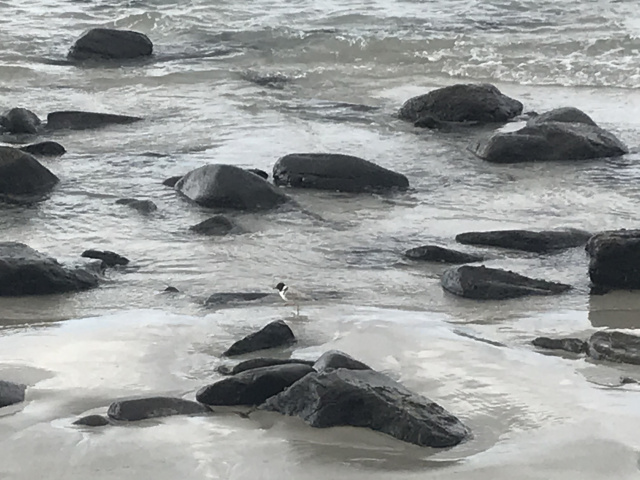What makes Cloudy Bay so significant ecologically? There are a broad array of unique ecological values.
In Cloudy Corner at the south-eastern end of Cloudy Bay – there is an internationally significant seaweed deposit, that provides important food and habitat for a number of migratory species.
There are three freshwater creeks that run directly out into the bay.
The full complement of Bruny Island’s shorebirds can be found at varying times in Cloudy Bay.
This includes Red-capped plovers (Charadrius ruficapillus), hooded plovers (Thinornis cucullatus), sooty oystercatchers, pied oystercatchers (Haematopus longirostris), Kelp gulls, pacific gulls, sea eagles, and terns. Bar-tailed godwits have also been seen here. On the far side of middle bay is a shearwater and Penguin rookery.
Pilot whales seasonally pass through the bay – and sometimes they have been seen washed up on the beach here.
This is an important coastal environment too for Benthic fauna (animals that live or occur at the bottom of a body of water) – crabs, molluscs, annelids, subsurface fauna are all here in great abundance and variety.
There are thousands of year old aboriginal middens in Cloudy Bays coastal dunes and surrounds too.
Rakali – water rats – (Hydromys chrysogaster) also frequent this coastal environment. This incredible species native to Australia and New Guinea has webbed hindfeet and waterproof fur, enabling it to swim well and catch fish and other marine species here off the beach and waterways.

Hooded plovers and oystercatchers, for example, breed on this beach and lay eggs on the soft sand. These birds are highly camouflaged and also, therefore highly susceptible to damage. Hooded plovers have an up to 95% failure rate in successfully breeding hatchlings. Human damage worsens this – disruption by dogs, human footsteps, and tyres from cars – all are devastating

Importantly - don’t drive on the beach - if you want to camp at Cloudy Corner – walk there - it's a wonderful walk. Don't bring dogs - dogs are banned from the beach on Cloudy Bay. When you are walking on the beach - keep off the soft sand where the birds lay their eggs - walk on the hard sand below the tide line. Don’t approach hooded plovers or oystercatchers - give the birds a wide berth. If you are near these birds - it is advised to avert your eyes – if they see you looking directly at them, they interpret this as prey behaviour and are more inclined to abandon their nests.
Cloudy Bay is an extraordinary place to see the wonders of the natural world, with your care, future generations can experience its beauty too.


James Bunker
independent researcher, BIEN
What makes Cloudy Bay so significant ecologically? There are a broad array of unique ecological values.
In Cloudy Corner at the south-eastern end of Cloudy Bay – there is an internationally significant seaweed deposit, that provides important food and habitat for a number of migratory species.
There are three freshwater creeks that run directly out into the bay.
The full complement of Bruny Island’s shorebirds can be found at varying times in Cloudy Bay.
This includes Red-capped plovers (Charadrius ruficapillus), hooded plovers (Thinornis cucullatus), sooty oystercatchers, pied oystercatchers (Haematopus longirostris), Kelp gulls, pacific gulls, sea eagles, and terns. Bar-tailed godwits have also been seen here. On the far side of middle bay is a shearwater and Penguin rookery.
Pilot whales seasonally pass through the bay – and sometimes they have been seen washed up on the beach here.
This is an important coastal environment too for Benthic fauna (animals that live or occur at the bottom of a body of water) – crabs, molluscs, annelids, subsurface fauna are all here in great abundance and variety.
There are thousands of year old aboriginal middens in Cloudy Bays coastal dunes and surrounds too.
Rakali – water rats – (Hydromys chrysogaster) also frequent this coastal environment. This incredible species native to Australia and New Guinea has webbed hindfeet and waterproof fur, enabling it to swim well and catch fish and other marine species here off the beach and waterways.

Hooded plovers and oystercatchers, for example, breed on this beach and lay eggs on the soft sand. These birds are highly camouflaged and also, therefore highly susceptible to damage. Hooded plovers have an up to 95% failure rate in successfully breeding hatchlings. Human damage worsens this – disruption by dogs, human footsteps, and tyres from cars – all are devastating

Importantly - don’t drive on the beach - if you want to camp at Cloudy Corner – walk there - it's a wonderful walk. Don't bring dogs - dogs are banned from the beach on Cloudy Bay. When you are walking on the beach - keep off the soft sand where the birds lay their eggs - walk on the hard sand below the tide line. Don’t approach hooded plovers or oystercatchers - give the birds a wide berth. If you are near these birds - it is advised to avert your eyes – if they see you looking directly at them, they interpret this as prey behaviour and are more inclined to abandon their nests.
Cloudy Bay is an extraordinary place to see the wonders of the natural world, with your care, future generations can experience its beauty too.

You might like...
Bruny Island Coastline
Bruny Island has an intricate, complex, beautiful and varied coastline, ranging from sheltered inlets, shallow bays, mudflats, lagoons, and grand sea-cliffs, through to long sandy ocean facing beaches.
Bruny Island wildlife
Bruny Island is a haven for rare and unique birds and animals, and is one of the best bird-watching spots in Australia.

Threatened Species on Bruny Island
Newsletter
Sign up to keep in touch with articles, updates, events or news from Kuno, your platform for nature
